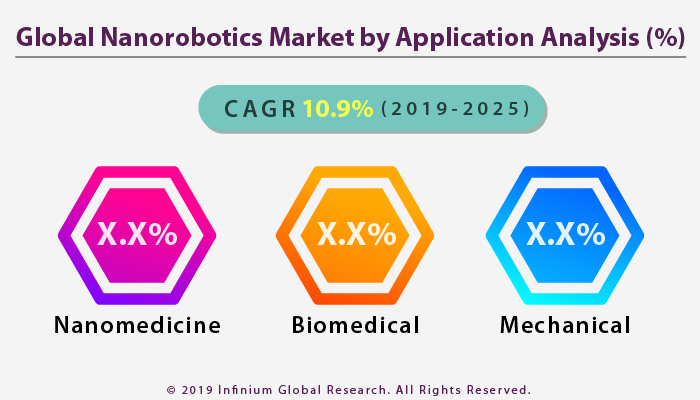Nanorobotics Market (Type - Nanomanipulator, Bio-nanorobotics, Magnetically Guided, and Bacteria-based; Application - Nanomedicine, Biomedical, and Mechanical): Global Industry Analysis, Trends, Size, Share and Forecasts to 2025
A recent report published by Infinium Global Research on the nanorobotics market provides in-depth analysis of segments and sub-segments in
the global as well as regional nanorobotics market. The study also highlights
the impact of drivers, restraints, and macro indicators on the global and
regional nanorobotics market over the short term as well as long term. The
report is a comprehensive presentation of trends, forecast and dollar values of the global nanorobotics market. According to the report, the global nanorobotics
market is projected to grow at a CAGR of 10.9% over the forecast period of
2019-2025.
Market Insight
Nanorobotics is the evolving technology of creating robots or
machines at the scale of a nanometer. The field of nanorobotics holds
considerable promise for advancing medical diagnosis and treatment due to their
unique ability to move and perform a complex task at small scales. Nanorobotics is finding their first and most prominent applications in medical science.
Nanorobotics help in research related to cancer, AIDS and other major diseases
as well as in helping brain, heart and diabetes research.
The growing demand for miniaturization is likely to contribute to
the growth of the global nanorobotics market. Additionally, other factors such as
initiatives undertaken by the governments to encourage investments in this
sector, increasing focus on nanotechnology, high demand for automation across
sectors, and growing advancements in molecular robots are responsible for the
growth of the market. However, the high manufacturing cost is one factor
affects the nanorobotics market. Furthermore, technological advancement and
higher acceptance of automated medical devices offer growth opportunities
for the nanorobotics market in the coming few years.
Geographically, the global nanorobotics market is segmented into
North America, Europe, Asia-Pacific, and RoW. North America is expected to hold
a significant share in the nanorobotics market throughout the forecast period.
The factor such as increasing adoption of nanotechnology, the presence of a
large number of nanorobotics manufacturers and growing focus on nanotechnology
and highly developed healthcare system triggers the market growth in the North
America region. Europe is the second-largest market for nanorobotics. The Asia-Pacific nanorobotics market is anticipated to grow at a maximum rate throughout the
forecast period. The growth of this region is attributed due to growth in the
elderly population and increasing disposable income. The Middle East and Africa
are projected to show a steady growth rate in the nanorobotics market.

Segment Covered
The report on the global nanorobotics market covers segments such as
type, and application. On the basis of type, the sub-markets include
nanomanipulator, bio-nanorobotics, magnetically guided, and bacteria-based. On
the basis of application, the sub-markets include nanomedicine, biomedical, and
mechanical.
Companies Profiled:
The report provides profiles of the companies in the market such
as Toronto Nano Instrumentation, JEOL, Ltd., Bruker Corporation, Kleindiek
Nanotechnik GmbH, Oxford Instruments plc, Klocke, Thermo Fisher Scientific,
Imina Technologies, Ginkgo Bioworks, and Other Companies.
Report Highlights:
The report provides deep insights into the demand forecasts,
market trends, and micro and macro indicators. In addition, this report
provides insights into the factors that are driving and restraining the growth
in this market. Moreover, The IGR-Growth Matrix analysis given in the report
brings an insight into the investment areas that existing or new market players
can consider. The report provides insights into the market using analytical
tools such as Porter's five forces analysis and DRO analysis of nanorobotics
market. Moreover, the study highlights current market trends and provides
forecast from 2019-2025. We also have highlighted future trends in the market
that will affect the demand during the forecast period. Moreover, the
competitive analysis given in each regional market brings an insight into the
market share of the leading players.
